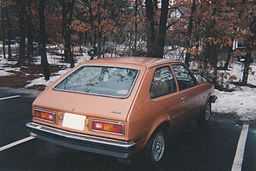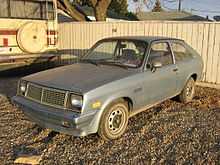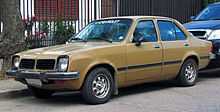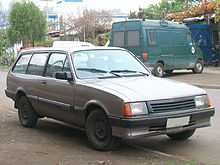Chevrolet Chevette
| Chevrolet Chevette | |
|---|---|
|
1978 Chevrolet Chevette 4dr Hatchback | |
| Overview | |
| Manufacturer | General Motors |
| Also called |
Pontiac Acadian/T1000/1000 Isuzu Gemini |
| Production | 1975–1987 |
| Model years | 1976–1987 |
| Assembly |
Wilmington Assembly, Wilmington, Delaware, United States Lakewood Assembly, Atlanta, Georgia, United States, Valencia, Edo Carabobo, Venezuela |
| Body and chassis | |
| Class | Subcompact |
| Body style |
3-door hatchback 5-door hatchback |
| Layout | FR layout |
| Platform | T-body |
| Related |
Opel Kadett Vauxhall Chevette Daewoo Maepsy |
| Powertrain | |
| Engine |
1.4 L G140 OHV I4 1.6 L G161Z I4 1.8 L 4FB1 diesel I4 |
| Transmission |
4-speed Saginaw manual 5-speed Borg-Warner T-5 manual 3-speed GM Hydramatic |
| Dimensions | |
| Wheelbase | 97.3 inches (1978 4 door), 95.3 inches (1978 2 door) |
| Length | 163.8 in (4,161 mm) |
| Width | 61.8 in (1,570 mm) |
| Height | 52.2 in (1,325 mm) |
| Curb weight | 1,843–2,035 lb (836–923 kg) |
| Chronology | |
| Successor |
Chevrolet Sprint (Canada) Geo Metro/Chevrolet Metro (United States) Pontiac LeMans |
The Chevrolet Chevette is a front-engine/rear drive subcompact manufactured and marketed by the Chevrolet division of General Motors for model years 1976-1987 in three-door and five-door hatchback body styles. Introduced in September 1975, the Chevette superseded the Vega as Chevrolet's entry-level subcompact and sold 2.8 million units over twelve model years.[1] and joined the Vega's reworked model called the Chevrolet Monza. The Chevette was the best-selling small car in the U.S. for model years 1979 and 1980.
The Chevette was one of GM's T-cars, those employing General Motors' global T platform. GM manufactured and marketed more than 7 million[1] rebadged variants on the T platform worldwide, including the Pontiac Acadian in Canada, Pontiac T1000/1000 in the United States (1981-1987), K-180 in Argentina, Vauxhall Chevette, Opel Kadett, Isuzu Gemini, Holden Gemini and, as a coupe utility (pickup), the Chevy 500. A T-car variant remained in production in South America through 1998.
Development
Under the direction of chief engineer John Mowrey[2] Chevrolet began developing the Chevette on December 24, 1973 in response to the 1973 Oil Crisis and GM's Energy Task Force, arising out of the crisis and the resultant shift in consumer demand to smaller, foreign vehicles boasting greater fuel-efficiency.
The Chevette used its basis GM's World Car, "Project 909" — what would become the T-car program, so named because the vehicles would share GM's T platform. With the well-known problems of its predecessor, the Vega — which included production issues, reliability problems and a serious propensity for corrosion — the team reworked the international platform such that the Chevette shared not a single body panel with another T-car and reworked the underbody extensively to enhance corrosion protection.[2] Ironically, the Chevette's 1.4 liter base iron block engine, weighed 59 lbs less than the Vega's much heralded aluminum block engine.[2]
The Chevette was officially launched on September 16, 1975, in Washington D.C. just after new legislation mandated Corporate Average Fuel Economy (CAFE) standards. With initial projected sales of 275,000 sales its first year,[2] numbers were cut in half as the price of oil stabilized. The Chevette would ultimately reach 2,793,353 sales[1] for its entire production across 12 model years 1976-1988.[1] and global T-car sales would surpass 7 million.[1] The last Chevette was manufactured on December 23, 1986, at Lakewood Assembly — following the end of production at Wilmington Assembly in September, 1985.[1] The last Chevette manufactured was a light blue 2-door hatchback shipped to a Chevrolet dealer in Springdale, Ohio.[1]
The T-car had been launched internationally in Brazil under the Chevette name in 1973, as a two-door sedan and ultimately a four-door sedan, a two-door hatchback, and a two-door station wagon (named Marajó), as well as a pickup (named the Chevy 500), produced until 1994.
Models years (1976–1987)
The Chevette itself was initially available only as a two-door hatchback with 1.4 OHV or 1.6 L OHC gasoline inline-four engines. Engines produced from 53 to 60 horsepower (40 to 45 kW) (subsequently 53 to 70 horsepower (40 to 52 kW)), driving the rear wheels. A four-speed manual transmission was standard; a three-speed automatic transmission was optional. Other features included rack-and-pinion steering, front disc brakes, front stabilizer bar, 13-inch tires, tri-color taillights, front bucket seats, onboard diagnostic system, extensive acoustic insulation, single steering column mounted stalk (integrating controls for signal indicators, wipers and windshield washers) and optional swing-out rear quarter windows.

Pontiac marketed a rebadged variant in Canada as the Acadian.[3] As the smallest, most fuel-efficient car marketed by Chevrolet, the Chevette was the lightest car marketed in the U.S.. The EPA rated the base 1.4-liter engine at 28 miles per US gallon (8.4 L/100 km; 34 mpg-imp) city and 40 miles per US gallon (5.9 L/100 km; 48 mpg-imp) highway. Chevrolet claimed that a Chevette's turning circle (30.2 feet) was one of the smallest in the world and that it was essentially a "metric" car, "international in design and heritage."[4] 1976-1978 Chevettes can be identified by round headlights and a chrome-rimmed, tri-color taillights.
Chevrolet marketed optional Rally and Woody packages as well as the least expensive Scooter model. The Rally 1.6, included a 1.6-liter (98 cu in) engine in lieu of the 1.4-liter (85 cu in) overhead-cam four-cylinder, rated at 60 hp (45 kW) instead of 52 hp (39 kW), along with a rear stabilizer and special body graphics. The Chevette Woody (1976) featured simulated wood grain siding and upgraded interior/exterior trim. The Scooter was offered as a base model with a $2,899 MSRP, two front passenger seats, an optional rear seat, deletion of most exterior chrome (e.g., window surrounds), painted rather than chrome bumpers, an open glove box, black carpeting, door pull straps in lieu of arm rests, fiberboard door panels, and a passenger seat without fore/aft adjustment. 9,810 Scooters were manufactured, versus 178,007 regular hatchbacks.
In 1977, engines offered 57 hp (43 kW) or 63 hp (47 kW). The Scooter hatchback included a rear seat, while offering a rear seat delete option. The Sandpiper trim package included “reef” patterned interior, deluxe door trim, cream gold or antique white exterior colors and an exterior Sandpiper logo just behind each door.
In 1978, models had a revised grille with a grid design, grille and headlight frames chromed for standard models, a four-door hatchback riding a 97.3 inches (2,470 mm) wheelbase was added — two inches longer than the two-door — and this version accounted for more than half of Chevette's nearly 300,000 sales. The 1.4 L engine and Woody were dropped. Fuel door added. TH-180 Automatic Transmission added to replace THM-200 series automatic. "HO" High Output version available in addition to the standard 1.6 L featuring a modified head and larger valves/cam profile. "HO" package also includes dual outlet exhaust manifold. Prices dropped and more standard equipment was added for 1978.
In 1979, the Holley two-barrel carburetor was now standard on all models. The front fascia was face-lifted with a flat hood, no longer wrapping down to bumper. New for 1979 was a large chrome grille with Chevrolet "Bow-Tie" emblem and square headlights. P.A.I.R. air injection system was introduced to improve catalytic converter function at idle. Active Passenger Restraint system was introduced in small numbers as an option which featured lower hanging dashboard, automatic seatbelts and a center dash console. Chevette sales totaled more than 451,000 units — a figure that would rank it second only to Chevy's new Citation, which had a much longer model run (sales had started in April 1979). Consumer Guide testers managed "an honest 29 mpg in the city and 39 mpg on the highway." The 1980 rear fascia was revised with a squared-off hatch, wraparound taillights with combined, single colored turn signals and a round gas filler door.
In 1981, a diesel engine option was new with a late 1981 availability — (1.8 L Isuzu unit). New styled steel wheels with center caps were offered and the previous wheel/hubcap design was discontinued. U.S. models received a new Computer Command Control feedback system on gasoline engines. The H.O. option was discontinued. EST (Electronic Spark Timing) was used on 1981 models only in place of manual timing advance. A new engine cylinder head design (swirl-port) is introduced to improve low-end torque and fuel economy. The Pontiac T1000 was introduced which shared all body stampings with Chevette, featuring a chrome center w/black trimmed grille & headlight buckets as well as standard chrome window trim with black area fill. Power steering was a new option (automatic trans. & A/C only) as well as a 3.36 axle ratio (standard on T-1000 models). The Active Passive Restraint system was discontinued. New lighter weight bucket seats were introduced that lacked much of the lower support of the heavier "panned" seats. A new adhesive-based, thinner windshield seal replaced the lock-ring type.
In 1982, models featured a five-speed manual transmission option on gasoline-powered two-door cars (standard with diesel). The Scooter was newly available in four-door hatchback. New GM THM-180C (THM200C for diesel model) automatic transmissions, which include a locking torque converter for greater fuel mileage. Introduction of pump driven A.I.R. system in late model year replaced P.A.I.R. to help efficiency of the catalytic converter. A new catalytic converter introduced with an air inlet for forced air injection from the air pump. A new one-piece cardboard based headliner, with updated over-head dome light, replaced the vinyl liner. Pontiac T-1000 received unique grille, body molding and vertical lined taillights as well as an alloy sport wheel option. GM of Canada's Pontiac Acadian, a rebadged Chevette, received all the T-1000's Pontiac-exclusive features from this point on. Chevrolet sold 433,000 Chevettes in 1981 and 233,000 in 1982.
In 1983, Chevettes had a makeover for the front and rear fascias, Chevette CS introduced. Black finished grill and trim moldings replaces most chrome pieces. Scooter and base Chevettes featured black bumpers and end-caps while the higher-end Chevette CS models included color-keyed bumpers and caps with chrome bumper inserts as an option. Scooter and base models featured black-only grill and headlight buckets while CS models feature argent colored trim. Chevette S model introduced as a cosmetic package that includes black painted styled-steel wheels and red-accented grill and moldings as well as over-sized decal emblems in red. Front bucket seats featured new adjustable knobs on the sides, but lost the reclining levers of previous years. Interior trim was also blacked out with new black door handles and black plastic window regulators. Integrated cassette deck optional with stereo package. Chrome strip on dashboard available only on CS & S models until end of production. Deluxe door panels were discontinued, all models featured plastic door panels, however base and Scooter models still featured laminated cardboard cargo area panels. The "Diagnostic Connector" was removed from wiring harness.

In 1984, the Scooter was discontinued. The T1000 was renamed "1000". 1985 carried few updates from the 1984 models. In 1986, the Chevette base model was discontinued leaving only the CS and the S, which featured a third brake light and an instrument cluster "Service Engine Soon" light, replacing the previous "Check Engine" light.
In 1987, Chevrolet dropped the Chevette S model and the diesel engine option (324 sold in 1986) and dropped the Chevette price to $4,995. Sales fell to just over 46,000 units, and production ended on December 23, 1986.
Electrovette
In the 1970s, General Motors Advanced Engineering developed a concept car, the Electrovette, based on the Chevette but using an electric motor powered by lead-acid batteries. The car had a range of about 50 miles (80 km) at 30 mph (48 km/h), and a top speed of 53 mph (85 km/h).[5]
Latin America
| Chevrolet Chevette | |
|---|---|
 Early Brazilian Chevette | |
| Overview | |
| Manufacturer | General Motors |
| Also called | GMC Chevette (Argentina) |
| Production |
1973–1994 (Brazil) until 1996 in Ecuador, 1998 in Colombia |
| Assembly |
Alvear, Santa Fe, Argentina (GMC Chevette), São José dos Campos, Brazil[6] Bogotá, Colombia[7] Quito, Ecuador (Aymesa) Montevideo, Uruguay Valencia, Venezuela. |
| Body and chassis | |
| Class | Subcompact |
| Body style |
3-door hatchback 2/4-door sedan 3-door station wagon |
| Layout | FR layout |
| Platform | T-body |
| Powertrain | |
| Engine | |
| Transmission | 4/5-speed manual |
| Dimensions | |
| Wheelbase | 2,395 mm (94.3 in) |
| Length |
4,161 mm (163.8 in) (1985 sedans) 3,961 mm (155.9 in) (1985 HB) 4,197 mm (165.2 in) (1985 Marajó) |
| Width | 1,570 mm (61.8 in) (1985) |
| Height |
1,325 mm (52.2 in) (1985) 1,385 mm (54.5 in) (1985 Marajó) |
| Curb weight | 836–923 kg (1,843–2,035 lb) (1985) |
| Chronology | |
| Successor |
Chevrolet Corsa Chevrolet Kadett/Ipanema |
The Chevrolet Chevette was first launched by General Motors (Brazil) in 1973 as a two-door sedan. A four-door sedan followed in April 1978, and then a three-door hatchback was added in November 1979.[8] The hatchback had unique bodywork for Latin America, longer than the European Kadett City and with a notch at the base à la the period Ford Escort. A three-door station wagon version, called the "Marajó" in Brazil, was added in September 1980, as was a sporting version of the hatchback called the 1.6 SR (with a mere four more horsepower, achieved by a somewhat higher compression ratio).[9] In 1983 the Chevette received a thorough facelift with rectangular headlights, with the turn signals located underneath the headlights, a flatter hood and single-piece grille. The dash was also new, as were ventilation windows in the front doors. Mechanically, the 1.6 was now also available to run on gasoól and a five-speed manual gearbox was available as an option.
The Latin American Chevettes underwent a series of facelifts, in 1978, 1983, and a major one in 1987 which meant new headlights and a black plastic grille. Where available, the station wagon used the Chevette name outside of Brazil.

The hatchback remained in production until 1988, while the Marajó continued to be available until 1989. Marajó is an island located at the mouth of the Amazon River in Brazil. The four-door sedan version was built until 1989, mainly for export to other Latin American countries. The two-door coupe remained in production until 1993, only outlived by the pickup version (Chevy 500) which continued until 1994 after having been first launched in 1983. The four-door sedan continued to be built for a few more years in Ecuador and Colombia.
The Chevette originally appeared with a 1.4-liter inline-four of Isuzu origins, albeit with a single overhead cam rather than the pushrod model originally used in the United States. This was later augmented by a locally developed 1.6-liter version, it too with a single carburetor. The Brazilian 1.6 was somewhat larger than the Isuzu-developed G161Z engine used in North America. After 1988, there was also a twin-carb version of the 1.6. The lower-powered 1.4 was eventually replaced, but as a tax cut for sub-1-liter cars appeared in late 1990, General Motors do Brasil responded with a 1-litre, 50 PS (37 kW) "Chevette Junior" for 1992.[10] The Junior had a brief shelflife, only remaining available until 1993. A 1.8 liter Isuzu diesel-engined version was also built,[11] exclusively for neighboring export markets as diesel passenger cars were not allowed in Brazil. In the Brazilian market, both the 1.4 and the 1.6 were available in gasoline and alcohol versions.
In Argentina, the Kadett C was originally marketed as the Opel K-180, but between 1980 and 1995 the equivalent of the Brazilian Chevette was sold there as the GMC Chevette. Production in Colombia, where a special version for taxi usage was also built, continued until 1998. The Chevette was the number one seller in Chile for some time, last in 1991. When catalytic converters were made a requirement in that country GMB was unable to develop such an engine and the Chevette was withdrawn from the Chilean market after the 1992 model year.[12]
Around 1.6 million units were built in Brazil, with the Corsa replacing the Junior and the Chevrolet Kadett/Ipanema replacing the bigger engined versions.

Chevy 500

The "Chevrolet Chevy 500" was the coupe utility version of the Brazilian Chevette. Launched in 1983, it was the precursor to the Classic/Corsa/Montana lineup of today. It competed with offerings from several other manufacturers, including the Fiat Fiorino, Ford Pampa, and Volkswagen Saveiro. Its payload was 500 kg (1,100 lb). Using the 1.6 liter OHC inline-four rated at 70 hp, this model continued in production until 1994 and was the last Chevette version built in Brazil.
Grumett
Created by Horacio Torrendell, a fibreglass-bodied version (actually based on the Vauxhall Chevette's bodywork) called the Grumett was built in Uruguay.[13] It was available either as a station wagon, as a pickup, or as a double-cab pickup. This replaced an earlier version (since 1976) which used bodywork based on that of the Vauxhall Viva, as well as Vauxhall mechanics. By 1980 the Vauxhall parts had become impossible to import and Grumett switched to Chevette parts from Brazil. The Grumett used the original 1.4 liter version of the Chevette engine.[13] The regular Chevette was also assembled in Uruguay, by General Motors Uruguaya. It was sold there as a two- or four-door sedan, either with the 1.4 petrol or the 1.8 diesel.[11]
Gallery
|
References
- ↑ 1.0 1.1 1.2 1.3 1.4 1.5 1.6 "1975, Chevrolet Turns to Opel for the New Fuel-Saving Chevette". General Motors.
- ↑ 2.0 2.1 2.2 2.3 "Chevrolet: A History from 1911, p. 165-166". Automobile Quarterly, Beverly Rae Kimes, 1987.
- ↑ Mays, James C. "1980 Pontiac Acadian". http://www.oldcarscanada.com''. Retrieved 18 April 2014.
- ↑ The Editors of Consumer Guide
- ↑ "GM's long road back to electric cars". CNN. April 7, 2009.
- ↑ "1982 Chevrolet Chevette "SL" (BR)" (in Spanish). Dkarros.com. Retrieved 2010-05-25.
- ↑ "Historia de Chevette" (in Spanish). Stcolombia.com. Retrieved 2012-09-08.
- ↑ Mastrostefano, Raffaele, ed. (1985). Quattroruote: Tutte le Auto del Mondo 1985 (in Italian). Milano: Editoriale Domus S.p.A. p. 175. ISBN 88-7212-012-8.
- ↑ Tutte le Auto del Mondo 1985, p. 176
- ↑ Aichele, Tobias, ed. (1992). Auto Katalog 1993. Stuttgart: Vereinigte Motor-Verlage GmbH & Co. KG. p. 80.
- ↑ 11.0 11.1 Tutte le Auto del Mondo 1985, p. 189
- ↑ Bauner, David; Laestadius, Staffan (May 2003). "The introduction of the catalytic converter in Chile". Journal of Transport Economics and Policy (The University of Bath and the London School of Economics and Political Science) 37 (2): 181.
- ↑ 13.0 13.1 "Camioneta Grumett de 1981" [Grumett truck from 1981]. El Telegrafo (in Spanish). Paysandú, Uruguay. 2010-08-23. Archived from the original on 2012-02-17.
External links
| Wikimedia Commons has media related to Chevrolet Chevette. |
| « previous — Chevrolet, a marque of General Motors, road car timeline, United States market, 1980s–present | ||||||||||||||||||||||||||||||||||||
|---|---|---|---|---|---|---|---|---|---|---|---|---|---|---|---|---|---|---|---|---|---|---|---|---|---|---|---|---|---|---|---|---|---|---|---|---|
| Type | 1980s | 1990s | 2000s | 2010s | ||||||||||||||||||||||||||||||||
| 0 | 1 | 2 | 3 | 4 | 5 | 6 | 7 | 8 | 9 | 0 | 1 | 2 | 3 | 4 | 5 | 6 | 7 | 8 | 9 | 0 | 1 | 2 | 3 | 4 | 5 | 6 | 7 | 8 | 9 | 0 | 1 | 2 | 3 | 4 | 5 | |
| Subcompact | Sprint | Geo | Metro | Spark | ||||||||||||||||||||||||||||||||
| Chevette | Aveo | Sonic | ||||||||||||||||||||||||||||||||||
| Spectrum | ||||||||||||||||||||||||||||||||||||
| Monza | Nova | |||||||||||||||||||||||||||||||||||
| Compact | Prizm | Volt | ||||||||||||||||||||||||||||||||||
| Cavalier | Cavalier | Cavalier | HHR | |||||||||||||||||||||||||||||||||
| Citation | Corsica / Beretta | Cobalt | Cruze | |||||||||||||||||||||||||||||||||
| Mid-size | Malibu | Malibu | Malibu | Malibu | Malibu | |||||||||||||||||||||||||||||||
| Celebrity | Lumina | Lumina | ||||||||||||||||||||||||||||||||||
| Full-size | Impala | Impala SS | Impala | Impala | Impala | |||||||||||||||||||||||||||||||
| SS | ||||||||||||||||||||||||||||||||||||
| Caprice | Caprice | Caprice | ||||||||||||||||||||||||||||||||||
| Personal | Monte Carlo | Monte Carlo | Monte Carlo | Monte Carlo | ||||||||||||||||||||||||||||||||
| Sports car | Camaro | Camaro | Camaro | Camaro | ||||||||||||||||||||||||||||||||
| Corvette | Corvette | Corvette | Corvette | Corvette | ||||||||||||||||||||||||||||||||
| Note | Vehicle is available for police departments only | |||||||||||||||||||||||||||||||||||
| « previous — Pontiac, a division of General Motors, automobile timeline, 1980s–2010 | |||||||||||||||||||||||||||||||||||
|---|---|---|---|---|---|---|---|---|---|---|---|---|---|---|---|---|---|---|---|---|---|---|---|---|---|---|---|---|---|---|---|---|---|---|---|
| Type | 1980s | 1990s | 2000s | 2010 | |||||||||||||||||||||||||||||||
| 0 | 1 | 2 | 3 | 4 | 5 | 6 | 7 | 8 | 9 | 0 | 1 | 2 | 3 | 4 | 5 | 6 | 7 | 8 | 9 | 0 | 1 | 2 | 3 | 4 | 5 | 6 | 7 | 8 | 9 | 0 | |||||
| Subcompact | Sunbird | T1000 | 1000 | LeMans | Matiz/G2 | Matiz/Matiz G2 | |||||||||||||||||||||||||||||
| Acadian | |||||||||||||||||||||||||||||||||||
| Sunburst | |||||||||||||||||||||||||||||||||||
| Firefly | Firefly | Firefly | Firefly | Wave | G3 | ||||||||||||||||||||||||||||||
| Compact | J2000 | 2000 | Sunbird | Sunbird | Sunfire | Pursuit/G4/G5 | |||||||||||||||||||||||||||||
| Tempest | Vibe | Vibe | |||||||||||||||||||||||||||||||||
| Phoenix | Grand Am | Grand Am | Grand Am | G6 | |||||||||||||||||||||||||||||||
| Mid-size | LeMans | Bonneville | Grand Prix | Grand Prix | Grand Prix | ||||||||||||||||||||||||||||||
| Grand Am | 6000 | ||||||||||||||||||||||||||||||||||
| Full-size | Laurentian | ||||||||||||||||||||||||||||||||||
| Catalina | |||||||||||||||||||||||||||||||||||
| Parisienne | Bonneville | Bonneville | Bonneville | G8 | |||||||||||||||||||||||||||||||
| Bonneville | |||||||||||||||||||||||||||||||||||
| Station wagon | Safari | ||||||||||||||||||||||||||||||||||
| Mid-size crossover | Aztek | Torrent | |||||||||||||||||||||||||||||||||
| Compact SUV | Sunrunner | ||||||||||||||||||||||||||||||||||
| Minivan | Trans Sport | Trans Sport/Montana | Montana SV6 | ||||||||||||||||||||||||||||||||
| Personal luxury | Grand Prix | ||||||||||||||||||||||||||||||||||
| Muscle car | Firebird | Firebird | Firebird | GTO | |||||||||||||||||||||||||||||||
| Sports | Fiero | Solstice | |||||||||||||||||||||||||||||||||
| Note | Vehicle not sold in U.S.A | ||||||||||||||||||||||||||||||||||


.jpg)